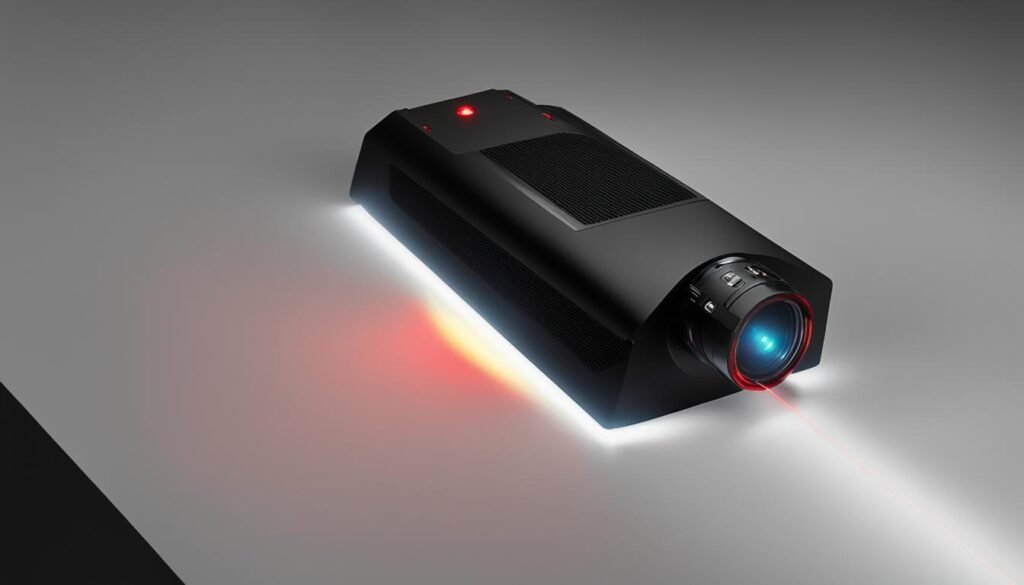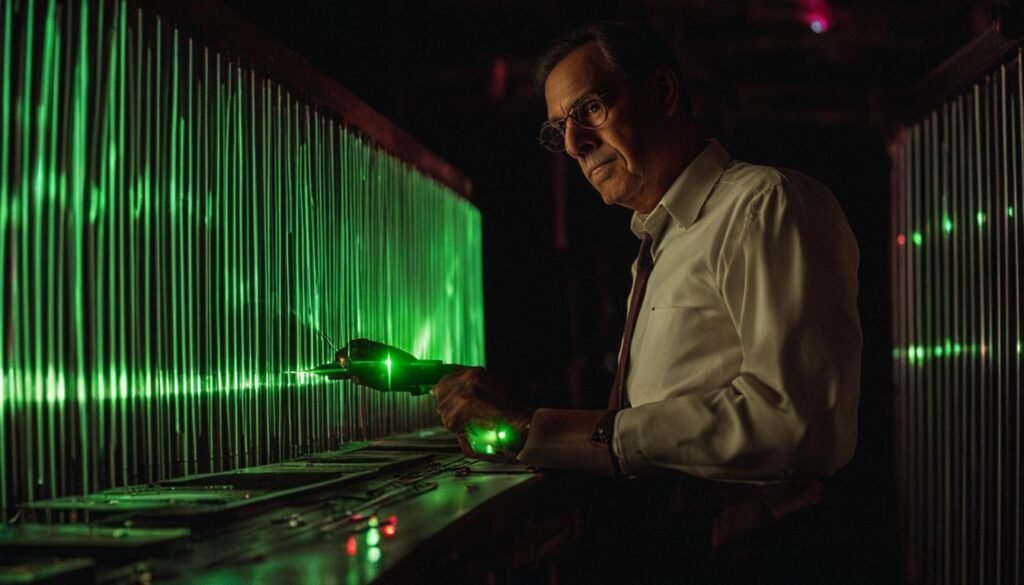Contents
- 1 The Applications of Laser Sensors
- 2 The Mechanism of Laser Sensors
- 3 The Inventor of Laser
- 4 Conclusion
- 5 FAQ
- 5.1 What industries utilize laser sensors?
- 5.2 What are some common applications of laser sensors in industrial manufacturing?
- 5.3 How are laser sensors utilized in the medical field?
- 5.4 What role do laser sensors play in communication systems?
- 5.5 In what scientific fields are lasers used for research?
- 5.6 What defense applications utilize laser sensors?
- 5.7 What are some entertainment applications of laser sensors?
- 5.8 How are laser sensors utilized in surveying and mapping?
- 5.9 How do laser sensors operate?
- 5.10 Who is credited with inventing the laser?
- 6 Source Links
Laser sensors, with their incredible precision, enhanced safety features, and improved efficiency, have revolutionized various industries. By harnessing the principles of laser technology, these powerful devices emit a highly focused beam of light, allowing for precise measurement and detection of objects and surfaces.
Industries such as manufacturing, healthcare, defense, and more have benefited immensely from the applications of laser sensors. They are utilized in industrial manufacturing for tasks like cutting, drilling, welding, and marking materials. In healthcare, laser sensors assist in surgical procedures, dental treatments, and cosmetic procedures like hair removal and skin rejuvenation. Communication systems rely on laser sensors for transmitting data over long distances, while researchers use them in scientific fields such as spectroscopy and microscopy. Laser sensors also find their place in defense applications like target acquisition, missile guidance, and directed energy weapons. Additionally, lasers are utilized in entertainment applications like laser light shows and 3D printing, as well as in surveying and mapping to measure distances, angles, and elevations.
The mechanism behind laser sensors lies in stimulated emission, where they consist of three main components: a gain medium, an optical cavity, and an energy source. The gain medium, when excited, creates a population inversion of electrons. The optical cavity reflects the light back and forth through the gain medium, amplifying it. Finally, the energy source, such as electricity or light, initiates the emission of photons, resulting in a highly focused and coherent beam of light that serves numerous applications.
Theodore H. Maiman, an American physicist and engineer, is credited as the inventor of laser technology. In 1960, Maiman created the first working laser, using a synthetic ruby crystal as the gain medium at Hughes Research Laboratories in California. This groundbreaking invention paved the way for the advancements and diverse range of applications we witness today.
Key Takeaways:
- Laser sensors enhance precision, safety, and efficiency in various industries.
- They have applications in manufacturing, healthcare, defense, communication, research, entertainment, surveying, and more.
- Stimulated emission is the mechanism behind laser sensors, involving a gain medium, optical cavity, and energy source.
- Theodore H. Maiman is credited as the inventor of laser technology, creating the first working laser in 1960.
- Laser sensors continue to evolve and hold great potential for future applications and discoveries.
The Applications of Laser Sensors
Laser sensors have a wide range of applications across different fields. In industrial manufacturing, they are used for cutting, drilling, welding, and marking metals and other materials. These sensors provide precise measurements and enhance efficiency in production processes.
In the medical field, laser sensors are utilized for a variety of purposes. They play a crucial role in surgical procedures, aiding in the precision and accuracy of incisions. Laser sensors are also employed in dental treatments, allowing for more effective and minimally invasive procedures. Furthermore, lasers are used in cosmetic treatments such as hair removal and skin rejuvenation.
Laser sensors are also an integral part of communication systems. They enable the transmission of data over long distances, ensuring efficient and reliable communication. Laser sensors allow for high-speed data transfer in applications such as fiber optic cables and satellite communication.
Research fields benefit greatly from the use of laser sensors. They are extensively used in scientific experiments and studies, particularly in spectroscopy and microscopy. Laser sensors provide precise measurements and enable researchers to analyze and understand various phenomena at the atomic and molecular level.
In the field of defense, laser sensors have crucial applications. They are utilized in target acquisition systems, guiding missiles with precision and accuracy. Laser sensors are also utilized in directed energy weapons, providing effective and efficient means of neutralizing threats.
The entertainment industry has also embraced laser sensors. Laser light shows, commonly seen in concerts and events, utilize laser sensors to create mesmerizing visual effects. Additionally, lasers are used in 3D printing, enabling the creation of intricate and detailed designs.
In the field of surveying and mapping, laser sensors play a pivotal role. They provide accurate measurements of distances, angles, and elevations, allowing for precise mapping and construction planning.
Overall, laser sensors find extensive applications in industrial manufacturing, medical, communication, research, defense, entertainment, and surveying. Their ability to provide precise measurements, enhance efficiency, and improve safety make them indispensable tools in various industries.
The Mechanism of Laser Sensors

Laser sensors operate based on the principles of stimulated emission. They consist of three main components: a gain medium, an optical cavity, and an energy source. The gain medium is a material that can be excited to produce a population inversion of electrons. The optical cavity is a chamber that reflects the light back and forth through the gain medium to amplify it. The energy source, such as electricity or light, excites the gain medium and initiates the emission of photons. This process creates a highly focused and coherent beam of light that can be used for various applications.
The gain medium plays a crucial role in the functioning of laser sensors. It can be a solid, liquid, or gas that possesses specific properties to facilitate stimulated emission. When the gain medium is excited by an external energy source, such as an electrical current or another laser, it causes the electrons in the material to move to higher energy levels. This creates a population inversion, where more electrons exist in the excited state than in the ground state.
The optical cavity in laser sensors ensures that the emitted light remains trapped and undergoes multiple reflections between two mirrors or reflective surfaces. As the light bounces back and forth through the gain medium, it stimulates the emission of additional photons. This process amplifies the intensity and coherence of the light, resulting in a highly concentrated beam of laser light.
The energy source in laser sensors is responsible for exciting the gain medium and initiating the emission of photons. It can be an electrical current, flash lamp, or even another laser. The type of energy source used depends on the specific application and the desired characteristics of the laser beam.
Laser Sensor Components:
- Gain Medium: The material that can be excited to produce population inversion of electrons.
- Optical Cavity: The chamber that reflects light back and forth through the gain medium to amplify it.
- Energy Source: The external source that excites the gain medium and initiates photon emission.
“The mechanism of laser sensors, driven by stimulated emission, allows for the creation of a highly focused and coherent beam of light.”
| Component | Description |
|---|---|
| Gain Medium | A material that can be excited to produce a population inversion of electrons. |
| Optical Cavity | A chamber that reflects light back and forth through the gain medium to amplify it. |
| Energy Source | An external source that excites the gain medium and initiates photon emission. |
The Inventor of Laser

Theodore H. Maiman, an American physicist and engineer, is credited with the invention of the laser, a transformative breakthrough in science and technology. In 1960, Maiman achieved a remarkable milestone by creating the first working laser at the renowned Hughes Research Laboratories in California. This groundbreaking achievement laid the foundation for the development of laser technology and its wide-ranging applications in various industries.
Maiman’s groundbreaking laser was a ruby laser, which utilized a synthetic ruby crystal as its gain medium. The ruby laser operated by stimulating the ruby crystal with intense flashes of light, leading to the emission of a highly focused and coherent beam of laser light. This achievement marked a turning point in the field of photonics, a branch of science that deals with the generation, manipulation, and detection of light.
“I didn’t have any fear of failure. I told myself, ‘If the ruby laser doesn’t work, I don’t know what I will do next. But I know I will find something, because I believe in it.’ I never had a doubt.” – Theodore H. Maiman
Maiman’s pioneering work and his invention of the laser have had a profound impact on various industries and have revolutionized fields such as telecommunications, manufacturing, medicine, and scientific research. The ruby laser, as the first successful laser device, opened up new possibilities for precise cutting, drilling, welding, and marking in industrial manufacturing. In medicine, lasers have been instrumental in surgical procedures, diagnostics, and a wide range of treatments. Laser technology has also advanced the fields of communication, research, defense, and entertainment.
| Laser Applications | Key Industries |
|---|---|
| Industrial Manufacturing | Manufacturing, Automotive, Aerospace |
| Medical | Healthcare, Dermatology, Dentistry |
| Communication | Telecommunications, Data Transmission |
| Research | Science, Physics, Chemistry |
| Defense | Military, Strategic Technologies |
| Entertainment | Events, Laser Light Shows |
| Surveying & Mapping | Geospatial Analysis, Cartography |
Thanks to Theodore H. Maiman’s groundbreaking invention, lasers have become an indispensable tool in numerous industries, enabling precision, efficiency, and innovation. As technology continues to evolve, the legacy of Maiman’s invention lives on, with lasers playing a vital role in shaping the future of various sectors and driving further advancements.
Conclusion
Laser sensors, powered by the principles of photonics, have revolutionized various industries by unleashing a new level of precision, safety, and efficiency. Their applications span across industrial manufacturing, healthcare, communication, research, defense, and entertainment, making them indispensable in today’s technological landscape.
The mechanism of laser sensors, driven by stimulated emission, allows for the creation of a highly focused and coherent beam of light. This technology enables precise measurements, object detection, and surface analysis, providing invaluable insights and enhancing productivity in countless processes.
The invention of the laser by Theodore H. Maiman marked a significant milestone in the field of photonics, paving the way for a plethora of advancements. As technology continues to evolve, the future of laser sensors holds great potential for even more exciting applications and discoveries. With ongoing research and development, we can expect laser sensors to play an increasingly vital role in shaping the future of technology.
FAQ
What industries utilize laser sensors?
Laser sensors have applications in industries such as manufacturing, healthcare, defense, and more.
What are some common applications of laser sensors in industrial manufacturing?
Laser sensors are used for cutting, drilling, welding, and marking metals and other materials.
How are laser sensors utilized in the medical field?
Laser sensors are utilized for surgical procedures, dental treatments, and cosmetic treatments like hair removal and skin rejuvenation.
What role do laser sensors play in communication systems?
Laser sensors are employed in communication systems for transmitting data over long distances.
In what scientific fields are lasers used for research?
Laser sensors play a role in various scientific fields such as spectroscopy and microscopy.
What defense applications utilize laser sensors?
Laser sensors are used in defense applications like target acquisition, missile guidance, and directed energy weapons.
What are some entertainment applications of laser sensors?
Laser sensors are utilized in entertainment applications like laser light shows and 3D printing.
How are laser sensors utilized in surveying and mapping?
Laser sensors are used in surveying and mapping for measuring distances, angles, and elevations.
How do laser sensors operate?
Laser sensors operate based on the principles of stimulated emission, consisting of a gain medium, an optical cavity, and an energy source.
Who is credited with inventing the laser?
The invention of the laser is credited to Theodore H. Maiman, an American physicist and engineer.



